Read more related stories

Soy sauce, mirin (sweet rice wine), sake (rice wine), and sugar are all you need to make this all-rounder Japanese sauce called tare. In fact, “tare” is a general term for sauces used in Japanese cuisine. It figures in many of its dishes, from grilling (yakitori and yakiniku) to sushi and hotpot.
[READ: We asked chefs which condiments they can’t live without. Here are their picks]Throughout Japan, it also has many variations that often include additional ingredients such as garlic, ginger, oyster sauce, dashi, and vinegar.
It’s sweet, umami, and tangy—all the reasons why Lawrence Cua, owner of seafood sandwich shop Bun Appetit, loves to serve it with his favorite beef barbecue, wrapping it in a grassy and herby-tasting perilla leaf topped with uni and kimchi.
“I always associate tare and beef barbecue with something special, whether a trip to Japan/Korea or a gathering with family and friends at a restaurant or even at home,” he says. “It’s never just an ordinary meal when these are on the table.”
Tare
Ingredients
1/2 cup soy sauce
1/2 cup mirin
1/2 cup sake
1/4 cup brown sugar
Garlic, minced
Preparation
- Mix all the liquids and sugar in a saucepan
- Boil on low heat until sugar dissolves
- Dispense in a small dipping bowl then add minced garlic
- Serve with your favorite barbecue elements
That martial law took effect on Sept. 21, 1972 and thus it should be commemorated every year on that day is just one of the many pieces of misinformation surrounding the late dictator Ferdinand Marcos and his family. Yes, Proclamation No. 1081 declaring martial law in the country was signed on that day, but it wasn’t until Sept. 23 that Marcos Sr. declared it.
“On this day, Marcos stole Philippine democracy. Institutions were shut down, people were arrested, and many were killed,” reads an infographic by the Official Gazette illustrating the measures taken on the day of the declaration.
As we all know—some of us at least, given the degree of historical distortions about this era—this was only the beginning of many horrific human rights violations that by 1981 totaled to about 70,000 people imprisoned, 34,000 tortured, and 3,240 killed, based on data from Amnesty International.
Fifty years since that day, Marcos Sr.’s namesake is back in Malacañang Palace, making remembering the human toll of martial law an even more painful and seemingly futile exercise.
But these activities by universities, civic organizations, scholars, artists, historians, and more insist that we should never forget.
Here are some of the online and on-site events happening this whole month in commemoration of the 50th anniversary of the declaration of martial law.
Talks and forums
Sept. 17 – Center for Liberalism and Democracy’s “50 Years After: Mga Turo at Hamon ng Martial Law sa Bayan at Kasaysayan”
THIS IS AN IN-PERSON FORUM on the 9-year period of formal martial law, and how we can strengthen truth telling.
— Center for Liberalism and Democracy (@cldphilippines) September 12, 2022
50 YEARS AFTER: Mga Turo at Hamon ng Martial Law sa Bayan at Kasaysayan
📆17 Sept (Sat), 4PM
📌Bantayog ng mga Bayani, Quezon City#MLat50 #NeverAgain #NeverForget pic.twitter.com/nIMjVd0E7S
Sept. 21, 24, Oct. 1, 8, 15 – Human Rights Violations Victims’ Memorial Commission’s “Tao sa Tao: Mga Totoong Kwento ng Martial Law”
Film screenings and plays
Sept. 10 to 25 – Altermidya’s “Ang Katotohanan sa mga Marcos at Martial Law” free film showings
Sept. 15 to 21 – “Lav Diaz’s “Mula sa Kung Ano ang Noon” free streaming
Sept. 17 – US advanced screening of the documentary “11,103” in Redwood City, California
Sept. 19 to 20 – “Indi na Maliwat: Alaala ng Escalante” play
Sep 19 to 20, 22 to 23 – Matanglawin Ateneo’s Martial Law Film Festival
Tours
Sept. 17 – League of Filipino Students’ ”Historyahan Tour”
Sept. 17 – ACT Philippines’ “Martial Law @ 50 Lakbay-Aral”
𝗟𝗔𝗞𝗕𝗔𝗬-𝗔𝗥𝗔𝗟 𝗧𝗔𝗬𝗢!
— ACT Philippines (@actph1982) September 12, 2022
Join na sa Martial Law @ 50 Lakbay-Aral! Kitakits sa Sept 17, 7am, UP Diliman. Maaaring magpalista rito: https://t.co/Lglr9Bo7SR#ML50#MarcosNoHero#NeverAgain#NeverForget pic.twitter.com/ukBD7iL7HQ
Sept. 18 – Akbayan’s “Road Trip: A Martial Law History Bus and Walking Tour”
Art exhibits
Aug. 30 to Sept. 25 – Campaign Against the Return of the Marcoses and Martial Law’s “Golden Years: Weighing Philippine Martial Law” exhibit
Sept. 15 to March 18 – Ateneo Art Gallery’s “Dark Memories: Torture, Incarceration, Disappearance, and Death During Martial Law” and “Alaala ng Martial Law” exhibitions
Sept. 21 to 22 – “Gintong Batas” exhibit in Outremont, Quebec
Multi-event initiatives
Sept. 6 to 30: Ibon Foundation’s “Krisis at Batas Militar” exhibit, film screening, and book launch
Sept. 12 to 21 – The UP Institute of Human Rights’ martial law series “The Legal Construction of Dictatorship: We Remember”
Sept. 13 to 21 – SAKA’s “Martial Law @ 50” cultural events
Sept. 14 to Oct. 17 – UP Diliman Office for Initiatives in Culture and the Arts (UPD-OICA)’s “ML@50: Tugon at Tindig ng Sining”
Sept. 23 – UP Third World Studies Center’s diktadura.upd.edu.ph website launch and “Marcos Lies” book launch
With most of us coming back to the office (well, some workers never worked from home, TBH), it seems everywhere we go it’s crowded and hot—especially public transportation. It’s already the “Ber” months but apart from the occasional rains, it’s as if summer never left.
(It’s worth noting that the highest temperature recorded in Metro Manila last month was 36.5 °C, according to the Philippine Atmospheric, Geophysical and Astronomical Services Administration, only a few decimal points shy of matching 2022’s peak so far last May, which was at 36.9°C.)
I feel it every time I step out of the house. A less than 5-minute walk to the train station is enough to send me into a sweaty frenzy. Sure, I perspire a lot as a person, but it’s also the humidity. I could be wearing a tank top, or the airiest top and tiniest shorts I own and still, without fail, I would break into a sweat a few minutes after going outdoors. That’s climate change for us.

This temperature is magnified even more in the presence of other passengers in enclosed vehicles. Our collective body heat makes even the chilliest of air-conditioning but a gentle breeze. But taking mass transit is better than driving by yourself, emissions-wise—hence the need to keep advocating for better commuting conditions. While we do, here are a few things we can do to make our daily trips a little bearable.
If you can, leave early

The later it is in the day, the more humid it is so try to leave early. Nine a.m. is still bearable, if you ask me. Any time between 10 a.m. and 3 p.m. is hell. If you’re coming from somewhere far, traveling early might prove a challenge, and roads tend to be congested already within those hours. Personally, the sweet spot is around 6 to 7 a.m., when the sun has just risen and its rays are still just peeking through skyscrapers.
Dress light

Light as in airy fabrics (cotton and linen, no polyester!) and light as in white and light colors as they reflect light, unlike dark ones that absorb it, making you feel hot. If, like me, you tend to break into a sweat easily, consider packing extra clothes so you can change into it later. I also bring a soft towel or a handkerchief everywhere I go to easily wipe off perspiration.
Ditch the backpack

As handy as they are, backpacks tend to stick close to our skin, restricting airflow. Instead, opt for a tote bag, a messenger bag, or anything that can be carried away from your body, but still feels secure enough.
Bring a fan

Most modes of transportation are now air-conditioned—yes, even the MRT has new working air-conditioning units—but even that sometimes falls short in keeping passengers cool. Best to bring your own ventilation. Other than folding fans, there are handheld electric fans that you can wield when you feel hot, e.g. while waiting for a jeepney to fill or when waiting for the train to come on a poorly ventilated platform.
And if you find yourself walking in the peak of day under the scorching sun, an umbrella may come in handy for some shade.
Hydrate

Lastly, don’t forget to drink enough water to cool your body down and to replenish lost liquids from sweating. A bottle filled with cold water can also be used as a cooling contraption.
I’ve always loved eating out by myself. (Then again there are things I swore I loved until I didn’t —like starting stories with “I”). However, getting the chance to do so only lasted until the final stretch of college. That time to spend alone turned into working lunches to discuss our thesis, lunch dates because it was the only time my suitor and I had, and barkada breakfast/brunch between classes with newfound friends (yes, I spent most of college in solitude).
Before all these, it was just “I.” It was okay. I’d enter fast food chains alone—not unheard of for college students really, hogging a table meant for four all to myself with three seats to spare for my bag. In my head, this is where my meet-cute would happen. A stranger would ask if I minded sharing a table, we’d strike a conversation, and the rest you know from rom-coms. Though in reality, in the rare instances that someone has asked to sit next to me, it was to ask me about God or if I had spare change. I’d rather shoo them away than move to the singles bar stool area. Romantic aspirations aside and after a few of those encounters, I have been more than happy with my own company.
We need to be able to think of aloneness as not synonymous with sadness—most especially in terms of eating—but a greater enjoyment and appreciation of the self.
Back then, sometimes, when my allowance would, well, allow, I’d go on a date with myself to a “fancy” restaurant. (The now-closed Chocolate Kiss at Bahay ng Alumni was already fancy by my college standards.) Unlike fast food chains, these kinds of places have relatively fewer customers save for lunch and dinner. It is at these opportune moments that I’d indulge myself in, say, a slice of cake and a pot of tea, the bill enough to feed me lunch throughout the whole week. In my inner monologue, I’d convince myself, “Minsan lang naman.”
@redditsconfession 1000 IQ! #reddit #redditstories #redditreadings #askreddit #lifeprotip ♬ original sound – Reddit Stories
When you eat out alone, there are no awkward attempts at filling in dead air, no checks to be split, no piece of finger food left untouched out of “courtesy,” no thinking of plausible reasons to excuse yourself when you find that you don’t like the other party. It’s just you and your thoughts, as daunting as it sounds. But if you have a game plan, which takes years of developing, it’s not as bad, and can even be meditative.
Some people won’t dare eat out alone. It is scary to be out there on your own, yes, but there is also joy in solitude, especially in the context of eating. A thing I love about dining in sans plus one or more is that I can people-watch instead of engage in conversation. This way I get to flip the tables. I look at people as if eating out with others is the “taboo,” not eating alone. I’d whip out a book sometimes as I wait for my order—this was pre-democratized internet where there was barely any public WiFi, and LTE? What’s that? Yes, sometimes, it’s a cover. But other times, it seriously is an escape. I can read and eat in silence and consume ever smaller bites of a dish so it can last me longer.
Other people have ways of coping with the alienating feeling of being the lone diner on a restaurant table, too. A TikTok user said that when dining out by himself, he would bring out a pen and paper and pretend to jot down notes so the staff would think he’s a restaurant critic. It works out in his favor in the end. He receives stupendous service, extra servings per order, and complementary desserts and drinks. Genius.
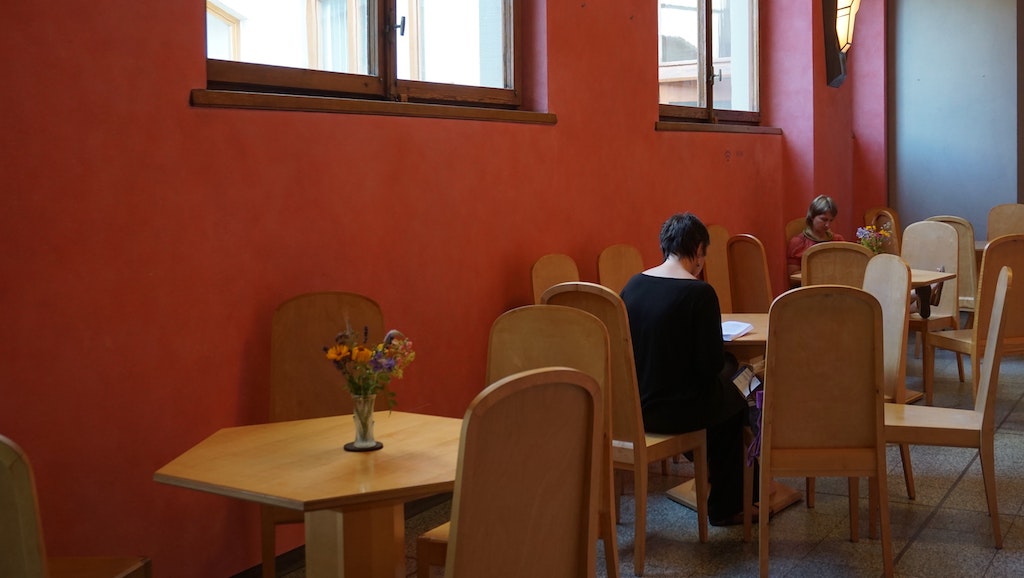
Eating alone, especially here in the Philippines where food and eating are seen as communal affairs, is often frowned upon, met with inquisitive, “concerned” looks. Every meal at home is served to a family with waiting stomachs rumbling in excitement (or forced enthusiasm, depending on who you ask). One simply does not skip family breakfasts, lunches, and dinners in Filipino households. You’re only off the hook if you’re sick or have pre-approved whereabouts.
Outside, a worried diner who’s spent their lifetime in those dining halls with their families looks on at a single person in a booth, with the curiosity of a child: Why are they eating alone? Is it not lonely? Could I possibly make them “happier”?
Don’t.
Chances are they are on their own by choice. Because even if it is unthinkable, doing things without the need for a companion is a necessary task. To be comfortable in your own company is a skill worth honing. Not everyone after all has the luxury of having their own rooms, their own safe spaces at home to do this in.
We need to be able to think of aloneness as not synonymous with sadness—most especially in terms of eating—but a greater enjoyment and appreciation of the self. I may look alone but I am having the time of my life eating this slice of cake that cost me a week’s lunch allowance. Please leave me and my cake alone.
You know text scams or smishing has worsened when a Supreme Court Justice tweets about it.
Justice Marvic Leonen expressed alarm yesterday about scam texts containing people’s names. He stipulates that a data provider has leaked, sold, or been careless about our information. “This makes all of us now vulnerable. Very dangerous,” he warned.
Text scams became rampant last year, with some people suspecting that these scammers got our numbers from the pesky contact tracing forms and apps we had to fill out everywhere we go during the height of the pandemic. But as one cybersecurity analyst notes, this is unlikely because phishing attempts have yet to be linked to tracing apps.
Little did we know, that was only the beginning.
Today, my work number—which I never use to sign up for anything—receives two to three job offers, congratulatory texts, and product recommendations daily. And sometimes, it will append each message with my name(!). Of course, these texts I dutifully block and report to my provider—as one should. But every time I do, they just come up with new numbers to pester me with.

The National Privacy Commission (NPC) said it is already investigating these name-specific text scams. According to its message to Inquirer, it is already working with the National Telecommunications Commission (NTC), the anti-cybercrime group of the Philippine National Police, as well as the major telecommunications companies to get to the bottom of the issue.
While the investigation has yet to be concluded, the NPC said they already have two hypotheses: one, it has something to do with a popular e-wallet platform based on how familiar the name format is; and two, following that format, it looks similar to that of messaging platforms Viber and Telegram. They added that the automated software programmed to do specific tasks was being used by unscrupulous groups or individuals.
As for telecommunications company PLDT, its bet is that apart from targeting messaging apps, the scammers are also using publicly available data to harvest names.
These days, hearing some popular food chain announce that an item is currently unavailable on their menu is not uncommon. Who could forget the fried chicken shortage earlier this year? Or that time when fries were off the menu because potatoes were low in supply?
The reason? Food shortage. Food security is being dubbed the next global health crisis by experts. And already, we Filipinos are feeling its effects. One thing the Department of Agriculture attributed low food supply to is the months-long standoff between Ukraine and Russia that continues to disrupt the shipment of food across the globe.
This was also predicted by the Philippine Chamber of Agriculture and Food Inc. as early as April this year, estimating that we will feel its brunt by end of this year—which unfortunately for us is holiday season.
[READ: Here’s how much basic commodities’ prices have changed—in 2022 alone]But even though we are just within the last stretch before it’s officially unofficial Christmas season (you know how we Filipinos celebrate as early as September), a popular Noche Buena item is already in low stock: queso de bola. This in turn affected the availability of another beloved Filipino yuletide snack, ensaymada. Coupled with the ongoing sugar crisis that has so far affected the beverage industry, we could expect more sugar-laden products—aka most grocery items—to be hit.
Other than sugar though, here are other food items that are apparently currently on shortage:
Salt

Forget that we are an archipelago surrounded literally by salt water, turns out we are importing over 90 percent of our salt supply. According to the DA, this is due to the decline in salt production induced by poor quality control and stalled developments. If it’s any consolation, the Department of Trade and Industry assured the public recently that we have enough supply and that the recent price hike is only reasonable since salt prices haven’t changed in years.
White onion and garlic
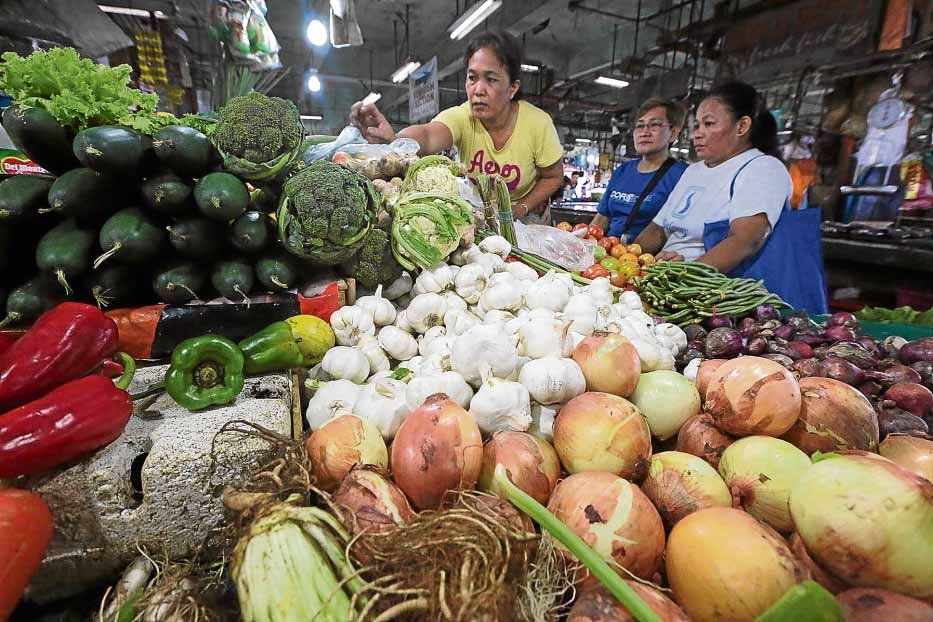
Other than human’s oldest known seasoning salt, the food crisis is also posing a threat to two of Filipinos’ beloved spices. White onion and garlic, which we mostly import, are projected to be in low supply later this year, according to the DA, despite, well, imports. Garlic lovers, sorry to tell you but you might need to hit the brakes on adding too many cloves than a recipe requires.
Kamote
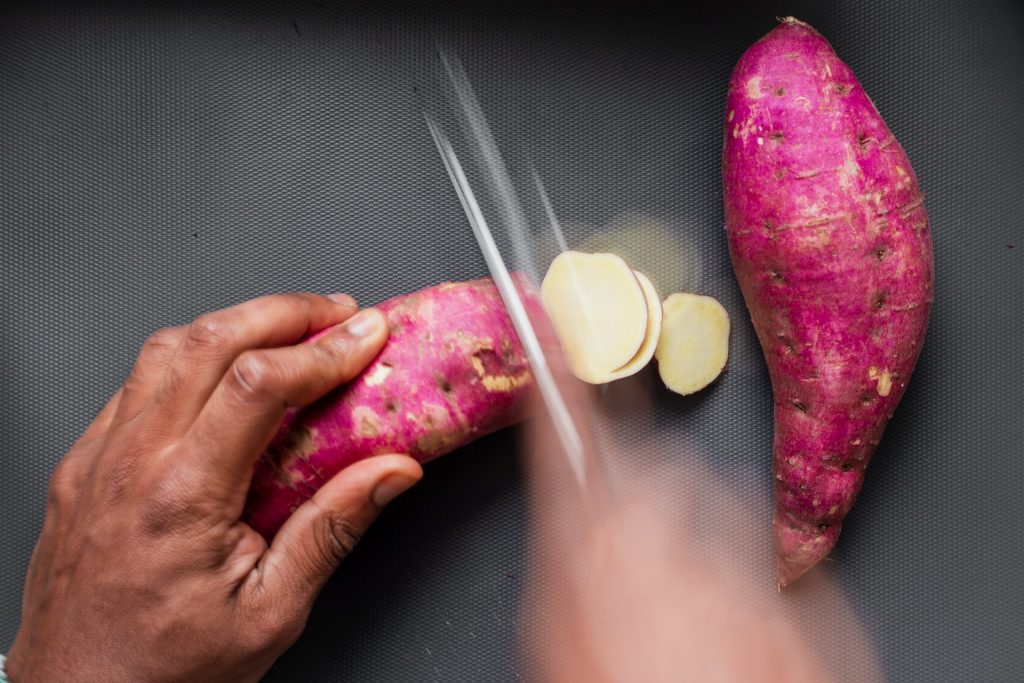
If not for a mall-based food business’ advisory that their best-selling sweet potato chips will temporarily be unavailable due to supply problems, the public wouldn’t be made aware of the kamote shortage. The DA later admitted that the root crop has been in decline since July, mostly because the rainy season affects its growth. But the agricultural bureau also assured the public that come October, kamotes will grow bigger and its price will go down.
Other than stocking up on these crops or weathering their prices, self-sufficiency can also help buffer supply woes. Did you know, for example, that you can grow your own vegetables at home, even in small spaces? Yes, you can. And some vegetables, including kamote tops, garlic, and onion, can be grown from scraps, too. That’s a win against food waste and for food security.
Fish is a fixture on Filipino tables, understandably so given that we are home to over 3,000 fish species. There are many ways to go about cooking these sublime creatures. Among many other recipes, we stew them in sour broth, fry and coat them in sweet and sour sauce, smoke, grill, debone and bake, marinate in vinegar and fry, steam and top with aromatics. Fish are stars in their own right.
[READ: Fish fest: The difference between daing, tuyo, and buwad]But sometimes we are found wanting to pair them with something other than sarsa, soup, or sawsawan. Another viand perhaps? And most often than not, it’s vegetables. Fried galunggong, moreso, is notoriously versatile to pair with lots of plant-based dishes, ginisang monggo chief among them. Another exceptional tandem to galunggong’s hefty flesh is a creamy, melt-in-your-mouth ginataang kalabasa, for the latter is too velvety, so a bite begs the addition of something to chew on. Plus, it doesn’t hurt that it imparts a nice saltiness—those who are all too familiar would know that vegetables are in dire need of it—just like bagoong in pinakbet.
So imagine our delight when we found that galunggong and kalabasa can actually be made into one viand and blend so seamlessly. It’s like having known it for a long time but only having the words to pin it down just now.
These patties are a melting pot of the things we love about galunggong and kalabasa: the fish’s meaty flakes embraced by the sweet starchiness of squash. It almost gives okoy (at least the kind made with kamote and peppered with krill) a run for its money. And indeed, it can be had on its own. But in a quest to pay homage to the duo of galunggong and kalabasa as separates, we thought it best to pair with rice and slathered with a creamy tomato-based sauce.
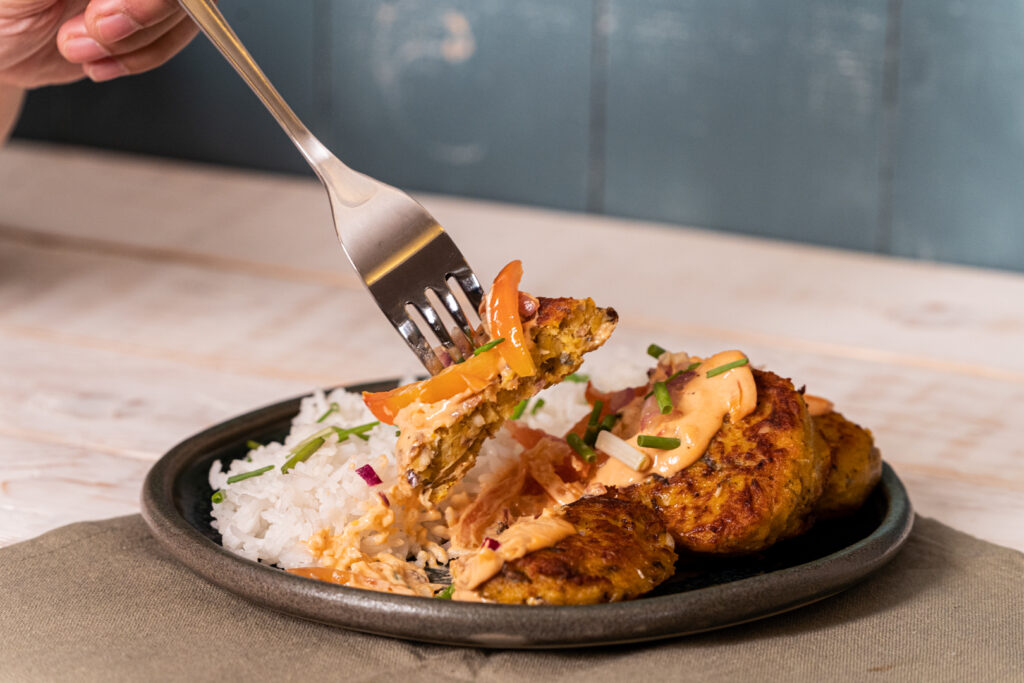
Galunggong squash patties
Ingredients
For the patties
1 cup cooked galunggong (about 2-3 pcs.), flaked
1 cup boiled squash, cubed
1 egg
¼ cup all-purpose flour
Cooking oil
1 pc. red onion, minced (reserve half for sauce)
5 cloves garlic, minced (reserve half for sauce)
For the sauce
2 pcs. tomato, julienned
¼ cup tomato sauce
⅔ cup cream
¼ cup water
Salt and pepper to taste
Spring onion for garnish
Steamed rice for serving
Preparation
- In a mixing bowl, add flaked galunggong and combine with onion, garlic, kalabasa, egg, and flour, and season with salt and pepper. Mix all ingredients and form patties using any round patty mold.
- Over medium fire, heat oil in a frying pan and fry patties until golden brown (2 to 3 minutes on each side). Transfer on a cooling rack to drain excess oil.
- Using the same pan with some of the frying oil, sauté garlic, onion, and tomato for 3 minutes until everything is soft and aromatic. Add tomato sauce, cream, and water. Let it gently simmer for 2 to 3 minutes. Season with salt and pepper.
- Serve with rice and garnish with spring onion. Enjoy!
Cinemalaya, one of the most anticipated independent film festivals, just wrapped up its first in-person screenings after two years of the pandemic. With 11 full-length and 12 short films on its roster, it was back in full swing at the Cultural Center of the Philippines and selected malls from Aug. 5 to 16. And while its lineup is, in fact, slated to make an online premiere later this year, catching them IRL still has its own allure (i.e. collective screams and gasps in theaters).

This is why Cinemalaya is extending its run in another location in Quezon City: Cinema ’76 Film Society in Anonas.
For P250, you can still watch independent films for another week, starting Aug. 24 until Aug. 30. Cinema ’76 will screen shorts and full-length films as early as 12 p.m. and as late as 8 p.m. To buy tickets, simply fill out this online form. The microcinema requires all audiences to be fully vaccinated against COVID-19.
Don’t know what to watch yet? See the list of winners at this year’s Cinemalaya here.
[READ: Check out the finalists of Cinemalaya 2023]Meanwhile, the opening film for Cinemalaya 2022, “Leonor Will Never Die” by Martika Ramirez Escobar, is open for private screenings at boutique cinema Sine Pop in Cubao. For P8,000, you can have your own screening at its renovated postwar address, which has a theater that can sit 25 people. Visit this form to book.
Escobar’s film won the Special Jury Prize for Innovative Spirit at this year’s Sundance Film Festival.
A trip to Baguio is never complete without a sweep of its public market for delicacies and pasalubongs like strawberry products, coffee beans, rare rice varieties, handmade crafts, and even fresh produce.
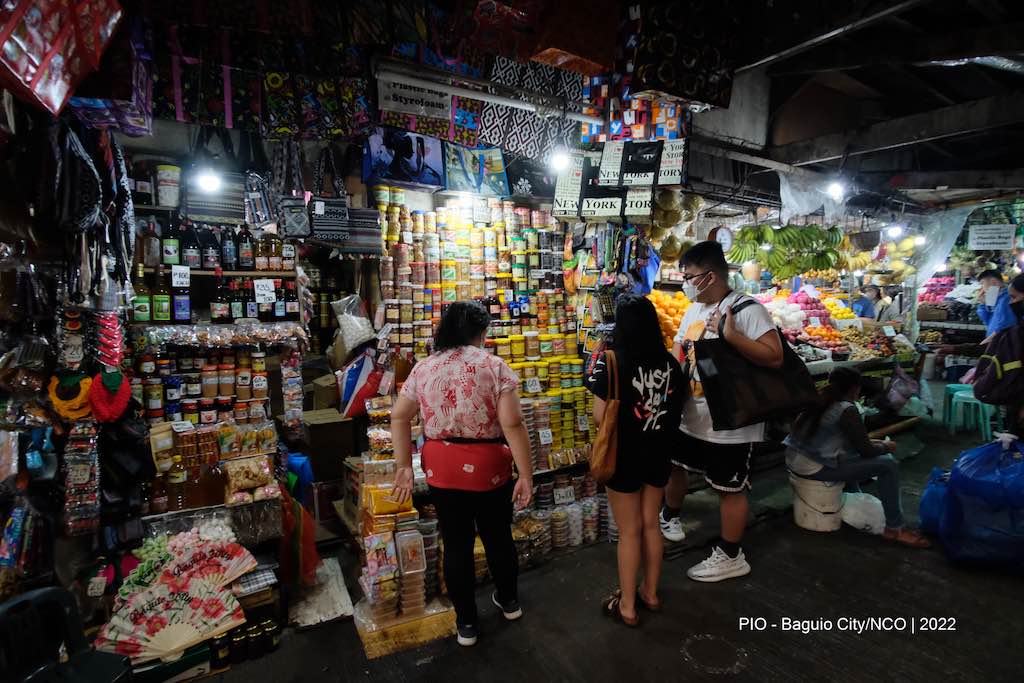
Pretty soon, you won’t need to bring cash to buy these goods as the local government is poised to become the first locality to adopt Bangko Sentral ng Pilipinas (BSP) and the Department of the Interior and Local Government (DILG)’s Paleng-QR Ph program. The initiative aims to build the digital payments ecosystem in the country by promoting cashless payments in public markets and public transportation, particularly tricycles.
Baguio City launched the program on Aug. 14, starting the rollout of quick response (QR) registration booths where market vendors and shop owners can create transaction accounts and print QR codes for their stalls.
Other than promoting contactless transactions amid the pandemic, DILG Secretary Benjamin C. Abalos believes this program can help improve the city’s collection systems, eliminate malpractices, speed up payment, and ensure integrity and transparency.
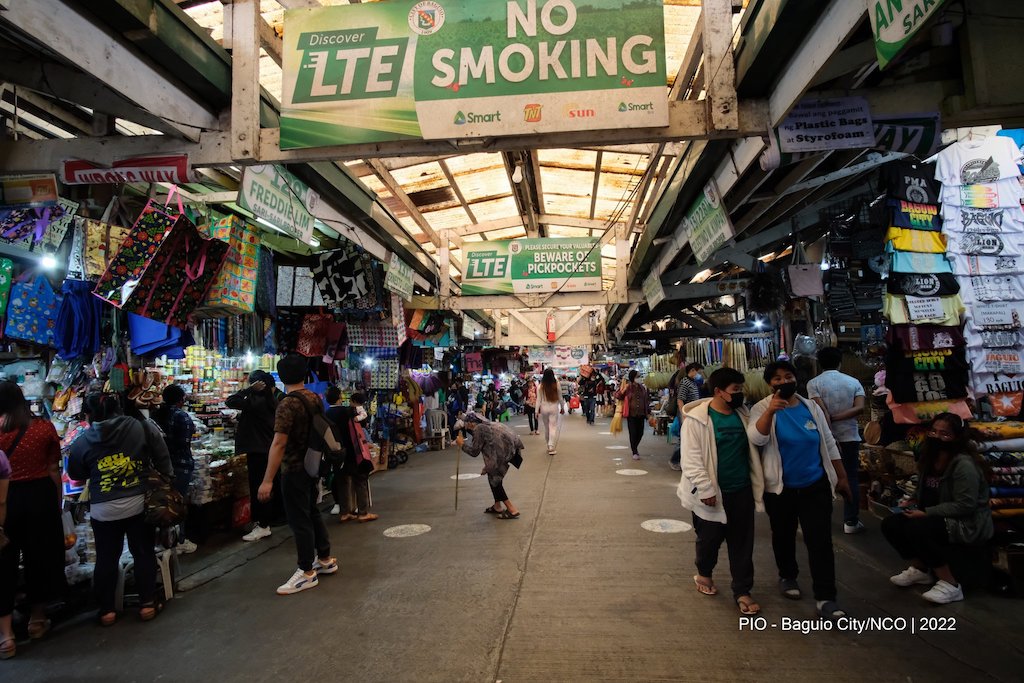
To encourage more sellers to adopt a cashless QR code-based payment, Baguio City Council also passed on first reading an ordinance that provides incentives to all business owners. Such perks include a five percent discount on all fees, licenses, permits and/or taxes in connection with the establishment, operation, and maintenance of the market stall in the first three years of the Paleng-QR Ph program. The five percent (5%) discount also applies to stall rental or rights in the first year of adoption.
According to BSP and DILG, the plan is to bring Paleng-QR Ph to palengkes around the country in a bid to digitize everyday transactions. The program, the central bank disclosed, was inspired by the student policy competition finalists from the University of the Philippines Los Baños in the 2021 BSP Youth Summit.
Digital wallets have been on the rise in the last two years especially since the pandemic necessitated contactless and cashless transactions. GCash and Maya, two of the leading e-wallet platforms in the country, have a combined user base of over 100 million. This number is projected to increase incrementally in the next few years.












